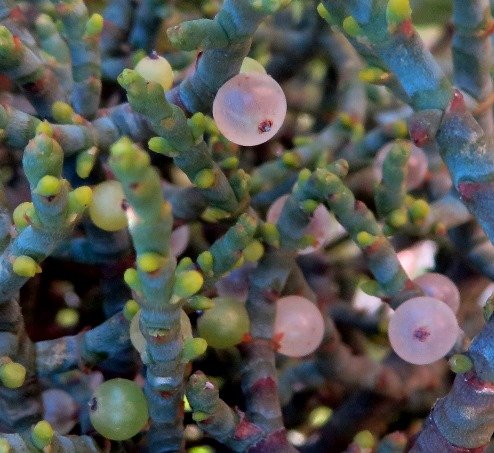Viscum capense ripe berries

The white to pale pinkish, translucent mistletoe or Viscum capense fruit becomes an attractive small sphere. It is attached stalkless to the parasite’s stem. The plant is female as there are fruit and the species dioecious. The small black mark stuck to the fruit’s tip like a navel is what remains of the style that formed part of the flower.
The similar V. hoolei, another parasite of this genus, grows its male and female flowers on the same plant, so they can all bear fruit.
Attractive to hikers in the veld in the aesthetic sense, these berries feature bigger in the lives of game and stock, some of their browsers. Birds are significant mistletoe seed distributors.
After eating the berry, the sticky birdlime, voëlent (bird vaccine) or mistletoe seed is rubbed or scraped off from the bird’s beak onto the branch the bird happens to be clutching in its feet at that moment.
In this way another parasite plant is “sown” up in the tree, ready to germinate and capitalise on the nutrients of its host tree or shrub. The tree has no say in the matter, as in paying tax. The “tax” burden is not evenly distributed among all trees, or even among the trees of a species, but what’s new?
This V. capense plant was seen in the Biedouw Valley, growing on a smallish Euclea tomentosa bush, unable to make a peep about it all but totally unconcerned with the complexities of human interest (Curtis-Scott, et al, 2020; Vlok and Schutte-Vlok, 2015; Shearing and Van Heerden, 2008; Bean and Johns, 2005; Le Roux, et al, 2005; iNaturalist).

